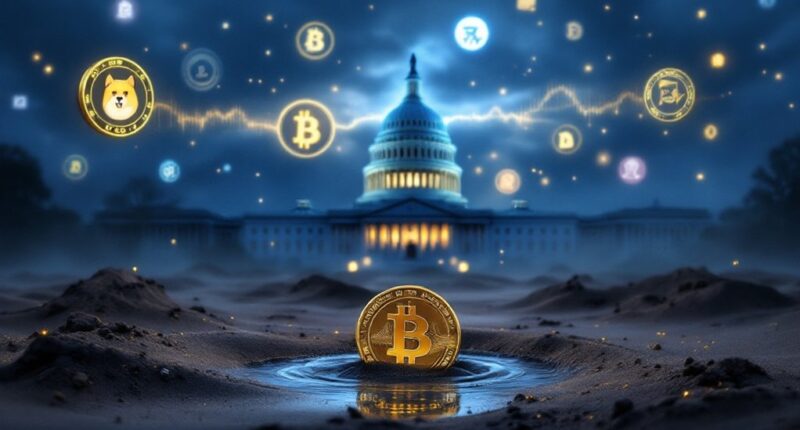Congressional lawmakers are demanding answers from the SEC about the lack of oversight in the booming meme coin market. Following controversial token launches like $TRUMP and $MELANIA that saw dramatic price swings, Senator Warren and Representative Auchincloss set a March 28 deadline for SEC explanations. Meanwhile, Representative Liccardo proposed the MEME Act to prevent officials from launching tokens. Critics compare the current situation to swimming in shark-infested waters without lifeguards. The regulatory battle continues to unfold as billions flow into these speculative investments.

Where exactly does a digital dog-themed token end and a regulated security begin? That’s the $9.5 billion question lawmakers are asking after the SEC’s surprising February statement declaring meme coins outside federal securities law.
The SEC’s Division of Corporation Finance likened these digital assets to collectibles driven by market demand rather than investment contracts, effectively creating a regulatory safe harbor. It’s as if baseball cards suddenly became a trillion-dollar industry, but nobody was watching the trading floor.
When meme coins become the new baseball cards, but with trillion-dollar stakes and zero umpires
This regulatory gap has caught Congressional attention, particularly following the controversial $TRUMP and $MELANIA coin launches. These tokens reached astronomical values before plummeting two-thirds within weeks—but not before Trump Organization affiliates, holding 80% of the supply, pocketed nearly $100 million in fees. Talk about the art of the crypto deal!
Senator Warren and Representative Auchincloss fired off a pointed letter on March 21, demanding explanations about this convenient loophole and potential conflicts of interest. The letter specifically questioned the SEC’s legal interpretation of meme coins and its impact on investor protection. Their deadline? March 28—barely enough time for regulators to find their crypto dictionaries.
Meanwhile, Representative Sam Liccardo isn’t waiting for explanations. His proposed MEME Act would ban officials from launching such tokens and even require Trump to return his meme coin profits. The legislation specifically targets potential exploitation of the public by politicians through meme coin launches. However, in the Republican-controlled Congress, this bill faces steeper odds than a knockoff Dogecoin reaching Bitcoin prices.
SEC Commissioner Hester Peirce, heading the crypto task force, suggests meme coins fall outside SEC jurisdiction entirely. The regulatory vacuum leaves investors vulnerable to scams with few protections under federal law—like swimming with sharks after removing all lifeguards from the beach. Some experts argue that privacy coin features could provide transaction transparency solutions while maintaining some user protections.
The controversy highlights a fundamental tension in crypto regulation: innovation versus protection. Without clear guidelines, the meme coin market resembles the Wild West, where fortunes are made and lost overnight.
As Washington debates, billions flow into these speculative investments, leaving ordinary investors exposed to extreme volatility with minimal safeguards. The question remains—will meaningful oversight arrive before the next meme-driven market explosion?
Frequently Asked Questions
What Defines a Meme Coin Legally?
Legally, meme coins are defined as crypto assets inspired by internet memes or pop culture that lack substantial utility beyond entertainment value.
According to SEC staff definitions, they typically fail the Howey test for securities classification because they don’t involve investment in a common enterprise with expectations of profits from others’ efforts.
Instead, their value stems primarily from market speculation and social factors, positioning them more as digital collectibles than financial instruments.
How Do Investors Identify Legitimate Meme Coins?
Savvy investors identify legitimate meme coins by conducting thorough due diligence across multiple dimensions.
They examine the project’s community engagement, scrutinize token distribution patterns, and verify smart contract audits by reputable firms.
They also assess liquidity levels, analyze developer transparency, and evaluate the project’s roadmap or unique concept.
Tools like blockchain explorers and trading analysis platforms help detect red flags such as suspicious transaction patterns or concentrated token holdings.
Can Meme Coins Be Regulated Without Stifling Innovation?
Regulators face a delicate balancing act with meme coins. Effective regulation likely requires a tiered approach—implementing disclosure requirements and consumer education while creating specialized regulatory sandboxes for experimentation.
International cooperation is essential to prevent regulatory arbitrage. The goal should be establishing guardrails that protect investors without crushing the creativity that makes these assets unique.
Like training a playful puppy, the challenge is setting boundaries without breaking its spirit.
What Penalties Exist for Meme Coin Fraud Promoters?
Meme coin fraud promoters face substantial penalties, including SEC fines up to $5 million for individuals and $25 million for entities.
Criminal charges can result in up to 20 years imprisonment. Influencers failing to disclose paid promotions risk fines and liability for fraudulently inducing investments, as seen with Kim Kardashian’s $1.26 million penalty.
Enforcement spans multiple agencies—SEC, DOJ, CFTC, and FTC—with international cooperation across borders targeting virtual asset fraud schemes.
How Are International Meme Coin Scams Being Addressed?
International meme coin scams face fragmented enforcement efforts across jurisdictions.
Regulatory bodies like the SEC and NYDFS are issuing notices and guidelines, while agencies have charged 18 individuals in a cross-border fraud operation.
However, challenges persist due to regulatory inconsistencies between countries, the rapid creation of new tokens (40,000-50,000 daily), and blockchain transparency limitations in identifying perpetrators.
The global nature of cryptocurrency makes coordinated enforcement particularly difficult despite growing awareness of these schemes.









